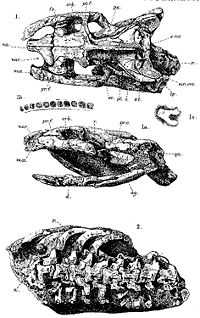Dinilysia
| Dinilysia Temporal range: Late Cretaceous, 85Ma | |
|---|---|
 | |
| Illustration of the skull and vertebral column | |
| Scientific classification | |
| Kingdom: | Animalia |
| Phylum: | Chordata |
| Class: | Reptilia |
| Order: | Squamata |
| Clade: | Ophidia |
| Family: | †Dinilysiidae |
| Genus: | †Dinilysia Woodward, 1901 |
| Type species | |
| Dinilysia patagonica Woodward, 1901 | |
Dinilysia (meaning "terrible ilysia") is an extinct genus of snake from the Late Cretaceous (Coniacian) of South America. The snake reached a length of 6-10 feet (1.8-3 meters) and preyed on smaller animals. The shape of the animal's skull does not support the suggestion that snakes were burrowers during their ancestry; it is clear that Dinilysia was terrestrial.

Restoration
In popular culture
According to supplementary material posted online at the BBC website, Dinilysia was the snake that appeared in the final episode of the 1999 documentary series Walking with Dinosaurs. The creature was live-acted by a modern day red-tailed boa, though the episode was set in North America, and Dinilysia lived 20 million years before Tyrannosaurus and in South America.
References
- Caldwell, M.W. & Albino, A.A., 2002. Exceptionally preserved skeletons of the Cretaceous snake Dinilysia patagonica, Woodward, 1901. Journal of Vertebrate Paleontology 22: 861-866.
- Fossils (Smithsonian Handbooks) by David Ward
- Dinosaurus: The Complete Guide to Dinosaurs by Steve Parker. Pg. 99
- Fossil Snakes of North America: Origin, Evolution, Distribution, Paleoecology (Life of the Past) by J. Alan Holman
| ||||||||||||||||||||||||||||||||||